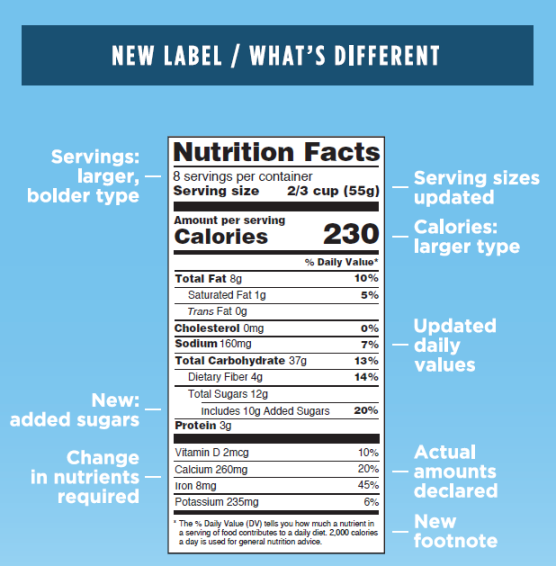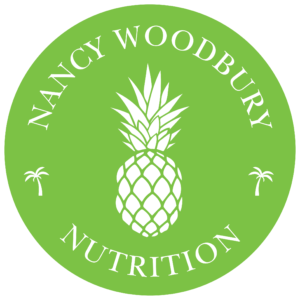
Did you know that chronic health conditions such as diabetes and heart disease can be improved by limiting or eliminating added sugars in your diet? I’m not suggesting a low-carbohydrate diet that eliminates nutrient-dense foods such as apples and oranges with naturally occurring sugars bound to fiber.
Instead, you should reduce your intake of added sugars, such as high fructose corn syrup added to processed foods. To help consumers, the FDA has ruled that by 2020 food manufacturers must use the newly-designed Nutrition Facts panel, which has been updated to include a separate line for added sugars as a subcategory of total sugars. It’s about time!
Where can I find out how much added sugars are in a packaged food?
Look at the Nutrition Facts panel under the heading for Total Carbohydrates, and Total Sugars will be listed as a subheading. The newest nutrition labels will include an additional subheading, “Includes ___g Added Sugars” to distinguish between the naturally occurring sugars such as lactose in milk, and the added sugars such as honey and molasses in foods. You may see different versions of the new Nutrition Facts label, including this one with a side-by-side comparison of a single serving with the whole package (not that anyone ever eats an entire pint of ice cream!!)
Can you identify the 56 different names for sugar found on the ingredient list of food packages?
University of California at San Francisco Pediatric Endocrinologist Robert Lustig, M.D. is the author of Sugar Has 56 Names: A Shopper’s Guide, a book related to his work revealing the negative health impact of excess sugar consumption. This Women’s Health Magazine article contains an infographic that lists the 56 names of sugar that consumers may not recognize. Nutrition ingredient labels list each type of sugar separately in order of weight. By themselves, the quantity of each type of sugar seems small, but when combined, the total amount of added sugars can be quite high.
Here are just a few names of sugar you might find on an ingredient list: agave nectar, blackstrap molasses, barley malt, dextran, date sugar, diastatic malt, diatase, muscovado, galactose, panocha, ethyl maltol, evaporated cane juice and treacle.
How much sugar is safe to consume?
The American Heart Association recommends limiting added sugars from all sources, including granulated sugar, honey, molasses, agave nectar, high fructose corn syrup (HFCS), maple syrup and many more. Some sweeteners such as blackstrap molasses may contain some nutrients such as calcium, iron and potassium, but most sweeteners have no nutritional value and contain 14 to 20 calories per teaspoon. Women should limit daily intake of added sugars to 100 calories or 6 teaspoons (24 grams), and men should limit daily intake to 150 calories or 9 teaspoons (36 grams).
What can I use to sweeten my foods?
Stick to the recommended limits for added sugars and avoid artificial sweeteners. You could easily add a teaspoon of sugar or honey to a cup of tea, a spoonful of molasses on roasted cauliflower with tahini, and a teaspoon of maple syrup on a whole-grain waffle with fresh berries, and keep your intake of added sugars within the recommendations without resorting to artificial or highly-processed sweeteners. Sweeten cooked oatmeal with cinnamon, apples, raisins and orange zest. Medjool dates can be soaked in warm water and blended into a paste that can be added to smoothies and other foods. One date contains 55 calories, 15 grams carbohydrate, calcium, potassium and fiber.
Is agave nectar healthier than sugar?
Agave nectar is made from the juice of the blue agave plant, which may sound healthy and natural, but it’s not. Agave nectar is highly-processed and, depending on the plant variety, it contains between 55% and 95% fructose, whereas table sugar or sucrose contains 50% fructose and 50% glucose.
Because fructose is metabolized in the liver, it doesn’t raise blood glucose levels as much as the glucose that is absorbed from table sugar. Agave nectar tastes 1.5 times as sweet as sugar, so less is needed to achieve the same degree of sweetness as sugar or honey. As a result, agave nectar has become trendy among people with elevated blood glucose. Unfortunately, consuming excessive amounts of fructose in agave nectar, HFCS, sweetened beverages and processed foods, may increase your risk of non-alcoholic fatty liver disease, insulin resistance, abdominal obesity and diabetes.
